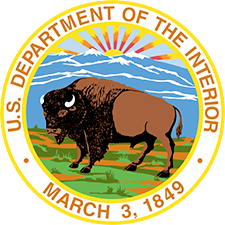Interior Department Announces Establishment of Two New National Wildlife Refuges in Wyoming and Tennessee

Wyoming Toad Conservation Area and Paint Rock River National Wildlife Refuge will conserve important habitat, expand outdoor recreation access
WASHINGTON — The Department of the Interior today announced the establishment of the Wyoming Toad Conservation Area in Wyoming and the Paint Rock River National Wildlife Refuge in Tennessee as the 569th and 570th units of the National Wildlife Refuge System, managed by the U.S. Fish and Wildlife Service (Service). The announcement comes as the nation celebrates National Wildlife Refuge Week, which commemorates the important role the Refuge System plays in providing vital habitat for wildlife species, offering outdoor recreation access to the public, and bolstering climate resilience across the country.
These additions – the second and third units added to the Refuge System under Secretary Deb Haaland’s leadership – are the culmination of decades-long, locally led efforts to conserve habitat for species while maintaining recreational access. In August 2022, the Department established the Lost Trail Conservation Area in Montana as part of the National Wildlife Refuge System. The expansion of the Refuge System furthers the Biden-Harris administration’s work to support community-driven efforts to conserve and restore the nation’s lands and waters through America the Beautiful.
“Nature is essential to the health, well-being, and prosperity of every family and every community in America. National wildlife refuges help connect Americans to a diverse array of public lands, while also serving as a crucial means of protecting wildlife and conserving habitat,” said Secretary Deb Haaland. “Through locally led collaborative conservation, these two special landscapes are now protected as part of our shared natural heritage and accessible to everyone.”
“The Service is grateful for incredible partnerships like these that lead to demonstrated successes across the country on behalf of wildlife and people,” said Service Director Martha Williams. “Locally led conservation efforts provide a lasting impact on our efforts to protect crucial wildlife habitat for threatened, endangered and priority species while prioritizing recreational access.”
The refuge system is an unparalleled network of 570 national wildlife refuges and 38 wetland management districts. National wildlife refuges provide vital habitat for thousands of species and access to world-class recreation, from fishing, hunting and boating to nature watching, photography and environmental education. There is a national wildlife refuge within an hour’s drive of most major metropolitan areas, almost all offering free admittance year-round.
National wildlife refuges contribute $3.2 billion per year into local economies and support more than 41,000 jobs, according to the Service’s report Banking on Nature. Visits to refuges have doubled in the last 10 years, reaching 67 million visits in 2022.
Wyoming Toad Conservation Area
The new conservation area, located in the Laramie Plains of the Wyoming Basin, will support the protection of habitat critical for the survival of the Wyoming toad, one of the most endangered amphibians in North America. The area is also important for the conservation of other species including the white-tailed prairie dog, pronghorn and migratory birds. The acquisition will provide future public access to the Laramie River and opportunities for outdoor recreation, including hiking, fishing, hunting, and wildlife observation.
The conservation area is the result of years of partner-driven work to conserve the Wyoming Toad, including with the City of Laramie, the Wyoming Game and Fish Department, and the Laramie Rivers Conservation District. In January 2017, the Service completed a land protection plan, a collaborative process that authorized the purchase of conservation easements and fee title lands from willing sellers in the area. The Service purchased 1,078 acres of land known as Bath Ranch from The Conservation Fund to officially establish the Wyoming Toad Conservation Area.
The Service purchased the land using funds from the Land and Water Conservation Fund(LWCF), which supports increased public access to and protection of federal public lands and waters and provides matching grants to state and Tribal governments for the acquisition and development of public parks and other outdoor recreation sites.
Paint Rock River National Wildlife Refuge
Tennessee’s newest national wildlife refuge will serve as a critical link between nearby state and nonprofit conservation lands in Tennessee and Alabama that help conserve the Paint Rock River watershed and one of the largest contiguous tracts of hardwoods remaining in eastern North America. The Paint Rock River National Wildlife Refuge is part of a unique ecosystem with a high diversity of aquatic, terrestrial, and karst habitats that support threatened and endangered species including gray bats, Indiana bats, Tennessee cave salamanders and Alabama cave shrimp. Its waters are home to 100 species of fish and 50 kinds of freshwater mussels, including some that are found nowhere else in the world.
In 2016, the Service developed a land protection plan for the Paint Rock River watershed through a public process, which authorized the purchase of conservation easements and fee title lands from willing sellers in Franklin County, Tennessee through a Conservation Partnership Area. The newly acquired 87-acre tract that establishes Paint Rock River National Wildlife Refuge was donated to the Service by The Nature Conservancy and the Open Space Institute. Refuge visitors will enjoy hunting, fishing, hiking and photography, if deemed compatible with refuge use.
Conservation areas are national wildlife refuges that consist primarily or entirely of conservation easements on private lands. These less-than-fee-title acquisitions, or easements, allow landowners to maintain working lands in their current configuration with no further subdivision or development, which supports conservation goals and helps to support a way of life for family farms and ranches. Fee-title acquisitions purchased from willing sellers can support additional wildlife-dependent recreation opportunities such as hunting, fishing, wildlife observation, photography, environmental education and interpretation.






